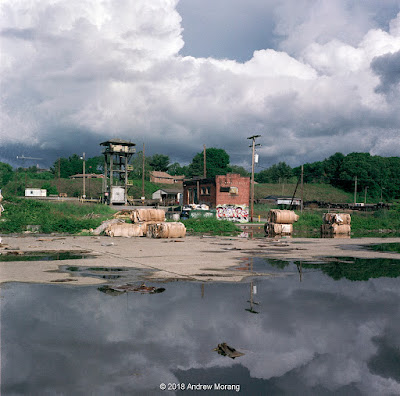 |
| Ranch House Cafe, Tucumcari, NM. Kodak BW400CN film, Yashica Electro 35CC camera, polarizer filter. |
Tucumcari is a Route 66 explorer's delight. It is chock full of closed or venerable motels, stores, and other 1950s detritus. According to the
Route 66 Adventure Handbook (by Drew Knowles), Tucumcari is known by people around the globe for its quintessential Route 66 cultural artifacts. As usual, I should have spent more time here with real film; the example above shows the potential.
Driving in from the west, one of the first places you encounter is the old Paradise Motel and Cafe. Well, it is not much of a paradise today. The main motel building looks like it is 1960s architecture; the Sinclair gas station possibly a bit older?
You can stay at the Buckaroo Motel. The office looks relatively modern, but the Buckaroo sign has a 1960s or 1970s appearance.
This Esso station also has a 1960s vibe. According to
Wikipedia, Esso (ˈɛsoʊ) was an acronym for Eastern States Standard Oil, one of the many companies spun off from Standard Oil in 1932. In 1972, most ESSO branded stations were replaced with the EXXON name.
Here is another abandoned filling station with not enough information to identify its original brand.
Here is the Magnolia - possibly another
Esso Texaco Teague Type C.
If you are hungry, the Ranch House Cafe (see the black and white frame at the beginning of this article) or Rubee's Diner will not be of much culinary use.
But divert from Route 66 and go downtown, and the El Pueblito Cafe is open.
And the La Cita with its Mexican Hat will serve you Mexican meals. The menu looked good but it was the wrong time for lunch.
There is a scattering of Art Deco architecture downtown, although not nearly as spectacular as you see in Albuquerque. The theatre is still operating, according to the
Route 66 Adventure Handbook. Good for it!
The Tucumcari Depot is another one of the handsome mission-style Santa Fe depots. It has been restored and contains a railroad museum.
Some of the commercial buildings downtown have decayed and collapsed. It is sad, another American small town that was once bustling and active.
Back to Route 66 at the east side of town, we have two more old-style motels, the Blue Swallow and the Tucumcari Inn. The Blue Swallow was built in the 1940s from surplus WWII cabins. I do not know if they are still present. Tucumcari Inn has seen better days - at $29.95, a long time ago (unless that was the hourly rate).
With a rather nondescript Polly Gas, we come to the end of Tucumcari. Tucumcari is a quintessential Route 66 town, and worth a return when I have more time and with black and white film.
The color frames are from a Fujifilm X-E1 digital camera with various lenses. The first photograph is from Kodak BW400CN film. This is a C-41 type of film, meaning it can be developed in the same chemicals as any color print film. Years ago, almost any drug store or film kiosk in a mall could develop C-41, but now you need to send the film to a professional laboratory. I often use
North Coast Photographic Services in California.




















































